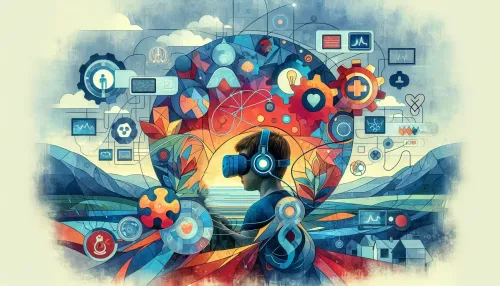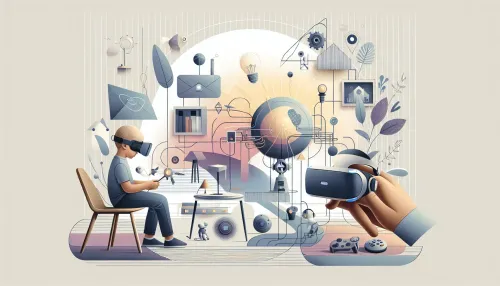Augmentative Reality: Opening New Dimensions for Autistic Children

The world of autism intervention and education is in perpetual motion, with innovative technologies frequently emerging as potential game-changers. Augmented Reality, or AR, has joined the ranks of these technological frontiers. At HorizonsMind Blog, we're delving into how AR is creating exciting new dimensions and avenues for autistic children to thrive.
Exploring Augmented Reality in Autism Therapy
Communication challenges are a hallmark of autism spectrum disorder, making it imperative to find tools that can act as bridges. AR presents an immersive way to facilitate communication without the pressures of direct human interaction. With visual prompts and interactive scenarios, AR can be used to rehearse conversational skills and understand social cues in a controlled environment. Picture a child practicing greeting gestures with a friendly AR avatar – it's low-stress communication training for real-world preparedness.
How AR bridges communication gaps for autistic children
Each child on the autism spectrum is unique, and AR acknowledges this by providing customizable learning experiences. A tailored AR app can help children expand their vocabulary using visuals linked with words catered specifically to their interests and learning pace. Such personalized experiences inspire more meaningful learning and accommodate the diverse cognitive styles that autistic children may have.
Related Article: Wearable Tech Advancements: Empowering Autistic Children with Innovative Therapeutic Interventions
Personalized Learning Experiences with Augmented Reality
Social skill acquisition can be a challenging journey for autistic children. HorizonsMind Blog recognizes that integrating AR into this pathway simplifies complex social interactions by simulating diverse scenarios. From playground dynamics to classroom etiquette, AR provides a visual-safe zone for practicing interaction patterns in varied settings. As these digital interactions build the child's confidence, they translate those skills into tangible social proficiency.
Customizable AR apps for unique learning needs
Sensory processing issues often accompany autism, making traditional educational environments overwhelming. Herein lies the beauty of tailored AR experiences: they create controlled sensory stimuli that children can navigate at their own pace. Visual filters and auditory cues can be adjusted in the virtual space to help autistic children learn how to manage sensory inputs before confronting them in the physical world.
Simulating social interactions in a safe environment
Play is a universal medium of connection, and when sprinkled with AR magic, it becomes even more captivating for autistic children. Augmented play can include interactive puzzles that promote teamwork or imaginative simulations where playmates adopt roles within an augmented scene. These activities are not only fun but also pivotal in building the scaffolding for effective social interaction skills that are essential for life's broader canvas.
Creating Safe Spaces: Managing Sensory Challenges with AR
Emotional literacy can be particularly nuanced for autistic individuals. There's growing evidence backed by compelling case studies that AR tools assist in understanding facial expressions and emotional cues. For instance, using an AR app that overlays emotive expressions onto faces helps in recognizing and naming emotions more confidently. Parents and therapists endorse these breakthroughs as they witness marked improvements in empathetic responses among autistic children who engage with such technology.
Augmented Play: Engaging Social Interactions for Autistic Children
Inclusivity breeds success, especially when technology adapts to suit individual requirements. For educational content within augmented reality, this means designers must closely collaborate with autism specialists to craft experiences rich with educational value yet sensitive to individual needs. From storylines that resonate with personal interests to pacing that aligns with learning speeds, tailoring content makes AR not just accessible but truly beneficial.
The role of interactive play in social skill development
Objective evaluation anchors technological application in therapeutic contexts firmly in reality. Quantitative assessments through consistent tracking of engagement levels, task completion rates, and behavioral indices paint a clear picture of cognitive progress in autistic children engaging with AR platforms. The data suggests significant strides in areas such as attention span, problem-solving capabilities, and memory recall all fundamental cognitive functions.
Related Article: Data-Driven Parenting: Leveraging Technology for Informed Decision-Making in Autism Care
Improving emotional literacy through augmented experiences
As we stand on the brink of cutting-edge advancements within augmented reality applications for autism, ethical considerations must parallel technological strides. The privacy of child users, balanced screen time, and ensuring accessibility across socioeconomic statuses are pivotal factors guiding future developments. By debating these matters today at forums like HorizonsMind Blog and incorporating best practices within development cycles, we sculpt a future where children on the spectrum can thrive via safe, ethical augmentative realities.
Frequently Asked Questions
Augmented reality (AR) serves as an immersive tool that aids autistic children in overcoming communication challenges. By providing visual prompts and interactive scenarios, AR allows children to practice conversational skills and understand social cues in a low-pressure environment, enhancing their readiness for real-world interactions.
Augmented reality simplifies the acquisition of social skills for autistic children by simulating various social scenarios. These controlled environments allow children to practice interaction patterns, such as playground dynamics and classroom etiquette, which builds their confidence and translates into improved social proficiency in real-life situations.
Personalized learning is crucial in augmented reality for autism education because each child on the spectrum has unique needs. Tailored AR experiences cater to individual interests and learning paces, fostering meaningful engagement and accommodating diverse cognitive styles, ultimately enhancing the educational experience for autistic children.
Check Out These Related Articles

Embracing Virtual Therapies: Enhancing Autism Care in the Digital Age

Virtual Reality (VR) Revolution: Transformative Impact on Social Skills Development for Autistic Children

Transforming Therapy Sessions: The Power of AR and VR for Autistic Children
